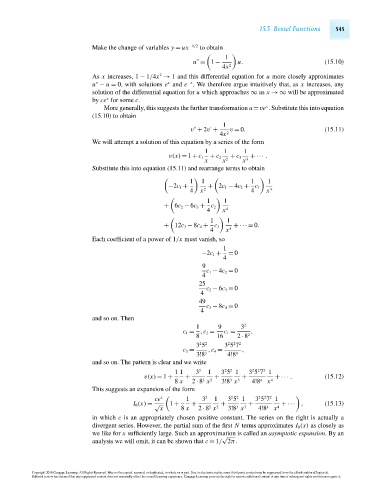Page 565 - Advanced_Engineering_Mathematics o'neil
P. 565
15.3 Bessel Functions 545
Make the change of variables y = ux −1/2 to obtain
1
u = 1 − u. (15.10)
4x 2
2
As x increases, 1 − 1/4x → 1 and this differential equation for u more closely approximates
−x
x
u − u = 0, with solutions e and e . We therefore argue intuitively that, as x increases, any
solution of the differential equation for u which approaches ∞ as x →∞ will be approximated
x
by ce for some c.
x
More generally, this suggests the further transformation u =ve . Substitute this into equation
(15.10) to obtain
1
v + 2v + v = 0. (15.11)
4x 2
We will attempt a solution of this equation by a series of the form
1 1 1
v(x) = 1 + c 1 + c 2 + c 3 + ··· .
x x 2 x 3
Substitute this into equation (15.11) and rearrange terms to obtain
1 1 1 1
−2c 1 + + 2c 1 − 4c 2 + c 1
4 x 2 4 x 3
1 1
+ 6c 2 − 6c 3 + c 2
4 x 4
1 1
+ 12c 3 − 8c 4 + c 3 + ··· = 0.
4 x 5
Each coefficient of a power of 1/x must vanish, so
1
−2c 1 + = 0
4
9
c 1 − 4c 2 = 0
4
25
c 2 − 6c 3 = 0
4
49
c 3 − 8c 4 = 0
4
and so on. Then
1 9 3 2
c 1 = ,c 2 = c 1 = ,
8 16 2 · 8 2
2 2 2
2 2
3 5 3 5 7
c 3 = ,c 4 = ,
3!8 3 4!8 4
and so on. The pattern is clear and we write
2 2
2 2 2
1 1 3 2 1 3 5 1 3 5 7 1
v(x) = 1 + + + + + ··· . (15.12)
3
8 x 2 · 8 x 2 3!8 x 3 4!8 4 x 4
2
This suggests an expansion of the form
2 2 2
2 2
ce x
1 3 2 1 3 5 1 3 5 7 1
I 0 (x) = √ 1 + + + + + ··· , (15.13)
3
2
x 8 x 2 · 8 x 2 3!8 x 3 4!8 4 x 4
in which c is an appropriately chosen positive constant. The series on the right is actually a
divergent series. However, the partial sum of the first N terms approximates I 0 (x) as closely as
we like for x sufficiently large. Such an approximation is called an asymptotic expansion.Byan
√
analysis we will omit, it can be shown that c = 1/ 2π.
Copyright 2010 Cengage Learning. All Rights Reserved. May not be copied, scanned, or duplicated, in whole or in part. Due to electronic rights, some third party content may be suppressed from the eBook and/or eChapter(s).
Editorial review has deemed that any suppressed content does not materially affect the overall learning experience. Cengage Learning reserves the right to remove additional content at any time if subsequent rights restrictions require it.
October 14, 2010 15:20 THM/NEIL Page-545 27410_15_ch15_p505-562

